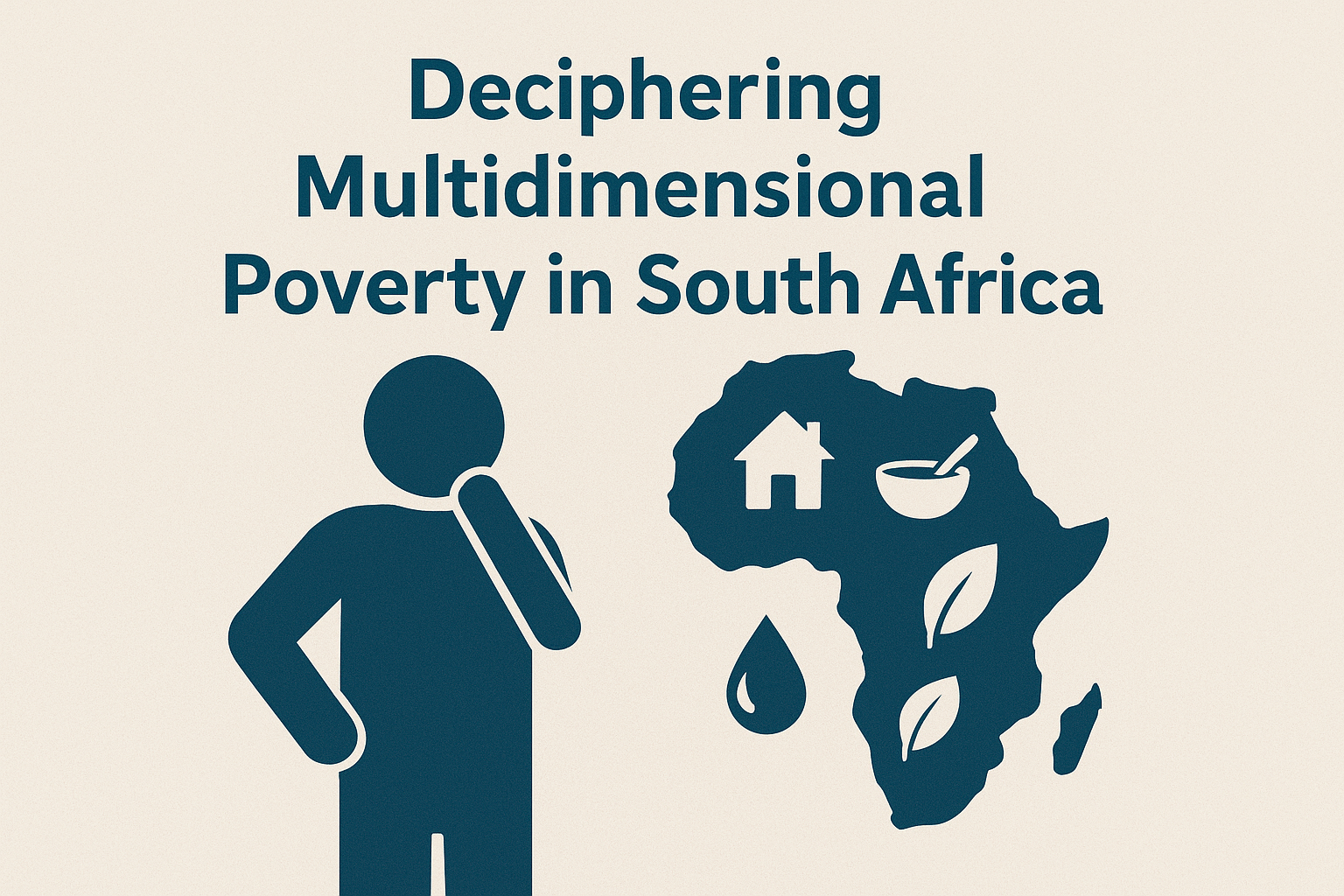Deciphering Multidimensional Poverty in South Africa: Exploring the Socio and Macroeconomic Factors

Downloads
Poverty in South Africa extends beyond income deprivation, reflecting a complex web of constraints that limit individuals' freedoms and capabilities. Grounded in Amartya Sen’s Capability Approach, this article redefines poverty as the lack of opportunity to achieve well-being across multiple dimensions with the primary objective to analyze multidimensional poverty in South Africa, and to establish how it can be measured to more specifically address and alleviate it in all its dimensions. This article evaluates poverty through seven interconnected dimensions: living standards, inequality, unemployment, education, health, interest rates and inflation, and financial inclusion. Methodologically, the study adopts a mixed approach combining qualitative insights with quantitative analysis through the Vector Error Correction Model (VECM) and supporting diagnostic tests. The most significant finding is that unemployment, school enrolment, real interest rates, and net personal wealth are the most influential drivers of poverty. These results confirm the complex and multifaceted nature of deprivation in South Africa. The article further shows that multidimensional poverty can be measured dynamically through time-series analysis, which reveals long-term relationships between key socioeconomic variables and economic well-being. Recommendations include integrating education with employment pathways and stabilizing macroeconomic variables such as interest rates and inflation to support sustainable poverty reduction.
Alkire, S., Foster, J. and Santos, M., (2020), Measuring multidimensional poverty: Insights from theory and practice. Oxford: Oxford Poverty and Human Development Initiative.
Bhatta, K.P. and Palikhe, G.K., (2020), Dimensions of poverty: A multidimensional approach. Kathmandu: Centre for Policy Research.
Bici, R., and Çela, M. (2017), Multidimensional Poverty and Education: Albania's Case. European Journal of Education Studies, 3(3), pp.140-150.
Bronfman, J. (2014), Beyond income: a study of multidimensional poverty in Chile. MPRA Paper No. 63256.
Comim, F. and Puyana, D., (2020), Capabilities, wellbeing and inequality in Latin America. Cambridge: Cambridge University Press.
Education and Development in South Africa, (2022), Addressing Educational Disparities to Reduce Poverty. South African Journal of Development Studies, 452, pp.180-200.
Enders, W., (2014), Applied Econometric Time Series. 4th ed. Hoboken, NJ: Wiley.
Fransman, T. and Yu, D., (2019), Multidimensional poverty in South Africa in 2001–2016. Development Southern Africa, 36(1), pp.50–79.
Gasper, D., (2019), Human well-being and economic development: The capabilities approach. International Journal of Development Issues, 18(2), pp.190–210.
Gujarati, D.N. and Porter, D.C., (2009), Basic Econometrics. 5th ed. New York: McGraw-Hill.
Haq, M., (1976), The poverty curtain: Choices for the third world. New York: Columbia University Press.
Ibrahim, A., Suleiman, H. and Musa, A., (2022), Financial Inclusion and Development in Africa. Abuja: Nigerian Economic Society.
ILO, (1976), Employment, growth and basic needs: A one-world problem. Geneva: International Labour Organization.
Johansen, S. and Juselius, K., (1990), Maximum likelihood estimation and inference on cointegration. Oxford Bulletin of Economics and Statistics, 52(2), pp.169–210.
Kane, T.J., (2008), Evaluating the Impact of Poverty Alleviation Programs: An Overview. Brookings Institution.
Lenoir, R., (1974), Les exclus: Un Français sur dix. Paris: Éditions du Seuil.
May, J. (2000), Poverty and Inequality in South Africa: Meeting the Challenge. David Philip Publishers, Cape Town.
National Planning Commission, (2020), National Development Plan 2030: Five-year review. Pretoria: Government of South Africa.
Ozili, P.K., (2020), Poverty and economic development in Africa. SSRN Electronic Journal. [online] https://ssrn.com/abstract=3574709
Poverty and Employment in South Africa, (2021), Addressing unemployment and its impact on poverty. Cape Town: Human Sciences Research Council.
Rodrigue, E., Kneebone, E., & Reeves, R. (2016), How 5 dimensions of poverty stack up, and who’s at the greatest risk. Brookings.
Shrestha, M., (2021), Measuring multidimensional poverty: South Asia perspective. South Asia Economic Journal, 22(2), pp.141–167.
Sida, (2017), Dimensions of Poverty: Sida’s Conceptual Framework. Swedish International Development Cooperation Agency.
Snyder, H., (2019), Literature review as a research methodology: An overview and guidelines. Journal of Business Research, 104, pp.333–339.
Statista. (2023), Socioeconomic Indicators - South Africa. Retrieved from https://www.statista.com/outlook/co/socioeconomic-indicators/south-africa.
Stats SA, (2020), Poverty trends in South Africa. Pretoria: Stats SA.
Streeten, P., Burki, S.J., Haq, M., Hicks, N. and Stewart, F., (1981), First things first: Meeting basic human needs in the developing countries. Oxford: Oxford University Press.
Toracco, R., (2021), Theoretical frameworks in qualitative research. International Journal of Qualitative Methods, 20, pp.1–9.
UNESCO, (2019), World Education Report. Paris: UNESCO. Wooldridge, J.M., (2016), Introductory Econometrics: A Modern Approach. 6th ed. Boston: Cengage Learning.
World Bank, (2018), Overcoming Poverty and Inequality in South Africa: An Assessment of Drivers, Constraints and Opportunities. Washington, DC: World Bank.
World Bank, (2024), Multidimensional Poverty Measure and South Africa Data. Available at: www.worldbank.org
Copyright (c) 2025 Mubanga Mpundu, Realeboga B. Thulo (Author)

This work is licensed under a Creative Commons Attribution-NonCommercial-NoDerivatives 4.0 International License.
By submitting your manuscript to IJABS, you agree and confirm that the paper you have submitted is your own original and unpublished work, does not contain any defamatory or other unlawful content(s), and you will accept responsibility for plagiarism. You and your co-authors retain copyright and grant BESRA the right of publication, with the work simultaneously licensed under a Creative Commons Attribution License 4.






